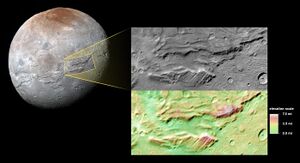Astronomy:Serenity Chasma
 The side of Charon viewed by the passing New Horizons spacecraft in July 2015 shows a system of “pull apart” tectonic faults, which look like ridges, scarps and valleys—the latter sometimes reaching more than 4 miles (6.5 kilometers) deep. Courtesy New Horizons mission/JHU/APL | |
| Location | Pluto-facing side of Charon |
|---|---|
| Coordinates | [ ⚑ ] : 19°N 5°W / 19°N 5°W[1] |
| Length | 200 km |
| Width | 40–50 km |
| Depth | 5–7 km |
| Discoverer | New Horizons |
| Eponym | Serenity, a spaceship in the Firefly series |
Serenity Chasma is the unofficial name given to a large pull-apart fault on Pluto's moon, Charon.[2] It is part of a series of faults that run along the perimeter of Vulcan Planum. It was discovered by the New Horizons mission, and informally named after the fictitious spaceship, Serenity.
Geology
Serenity Chasma is 200 km (120 mi) long, and about 5–7 km (3.1–4.3 mi) deep, and its typical width is 40–50 km (25–31 mi).[3] The northern wall continues for an additional 200 km as a scarp after exiting the chasma. The chasma is part of a global tectonic belt; a series of canyons, scarps, and troughs that traverse the face of Charon.[4] This series of faults is the longest known in the solar system.[2]
Serenity Chasma formed as the result of a subsurface ocean on Charon, which expanded as it froze. This expansion pushed the Oz Terra region higher and produced the fault belt across Charon's equatorial region.[2]
Landslides have been observed within Serenity Chasma. This is the only known occurrence of landslides in the Kuiper Belt.[5]
The lower portion of the Image shows colour-coded topography of the same scene Measurements of the shape of this feature tell scientists that Charon's Water ice layer may have at least partially liquid in its early history
See also
- List of geological features on Charon
References
- ↑ "USGS Astrogeology Science Center". https://astrogeology.usgs.gov/search?pmi-target=charon#expand. Retrieved 9 April 2020.
- ↑ 2.0 2.1 2.2 "Pluto's 'Hulk-like' Moon Charon: A Possible Ancient Ocean?". February 18, 2016. https://www.jpl.nasa.gov/spaceimages/details.php?id=PIA20467. Retrieved 9 April 2020.
- ↑ Beyer, Ross A.; Nimmo, Francis; McKinnon, William B. et al. (1 May 2017). "Charon tectonics". Icarus 287: 161–174. doi:10.1016/j.icarus.2016.12.018. PMID 28919640. Bibcode: 2017Icar..287..161B.
- ↑ Moore, J. M.; McKinnon, W. B.; Spencer, J. R. et al. (17 March 2016). "The geology of Pluto and Charon through the eyes of New Horizons". Science 351 (6279): 1284–1293. doi:10.1126/science.aad7055. PMID 26989245. Bibcode: 2016Sci...351.1284M.
- ↑ Cofield, Calla (October 20, 2016). "Look Out Below! Landslides Spotted on Pluto's Moon Charon" (in en). https://www.space.com/34443-landslides-on-pluto-moon-charon.html. Retrieved 9 April 2020.
 |

